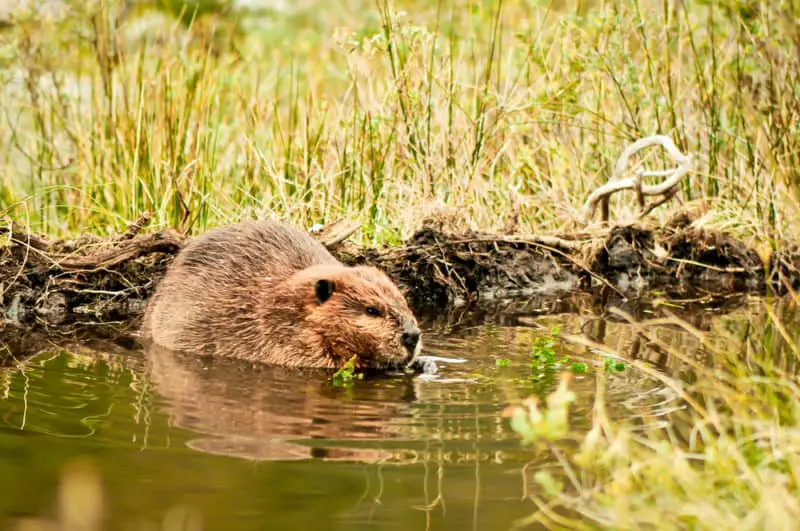Beavers (Castor Canadensis) are North America’s largest semi-aquatic rodents after the capybaras. Adult beavers weigh 45 – 60 pounds, but they are known to grow to 100 pounds.
People greatly respect these wetlands rodents, calling them “Little People” because, just like humans, they have the ability to rework their habitats to suit their needs. They have mighty jaws and constantly growing incisors, hand-like forepaws, and webbed hind feet, which they use to fell and drag trees and branches to build dams and their dwelling places.
Why Do Beavers Build Dams?
Beavers are made for life in the water. On land, their wide body and short legs make them slow and more vulnerable to predators. However, beavers are brilliant swimmers, and they’ve thus evolved to prefer the safety of the water. Incidentally, they can stay submerged for up to 15 minutes without surfacing to take a breath.
They build dams to form ponds to create an environment where they have maximum protection from predators. They construct their shelters, (lodges) on the bank of the pond they’ve created. These lodges have submerged entrance points that allow them to come and go under water when they want to find food or they sense danger. Within their lodges they live, rear their young and store food to use over the winter.

What Are Beaver Dams Made Of?
To make dams, beavers use any material within their vicinity so long as it can block/ slow water flow down. Some of the most common materials include:
• Tree trunks and branches
• Grass
• Rocks
• Mud
• Sticks
• Leaves
• Twigs
• Plants
• And more How Do Beavers Build Dams?
There isn’t a specific process that beavers follow to build dams. They predictably select building sites based primarily on the topography and food supply. These are often low-lying grounds with shallow, moving water, and in the surrounding, there must be trees that can fell across the river/ stream to slow down water flow. They use their powerful lower-jaw muscles and solid, sharp incisors to cut trees and branches. They then gather logs, sticks, stones/ rocks, and mud to add to the fallen trees to build a strong obstruction and anchor their dams. Depending on the water flow rate, they can also add more materials to achieve their desired dam size. The more area they flood, the more food they’ll safely access.
How Do Beavers Know How to Build Dams?
In the book My Beaver Colony, Lars Wilson, a Swedish biologist, carried out a behavioral study on young beavers he had separated from the adult ones. They hadn’t seen a beaver dam before nor had experience building one. He was astonished to realize that beavers’ dam-building instincts are often triggered by the sound of flowing water but not the sight.
He played a running water recording in one of the trials, and the young rodents build a dam in a still water tank. The second experiment was of the isolated beavers building a dam on a concrete floor next to a loudspeaker playing running sound. From these demonstrations, the conclusion was that beavers have the innate ability to build dams, but these evolutionary instincts are usually triggered by the sound of flowing water.
Where Do Beavers Live?
Beavers are found throughout North America except in Nevada deserts, California, and some parts of Arizona and Utah. They live in lakes, rivers, ponds, marshes, streams, and areas adjacent to wetland regions. Depending on their geographical location, these creatures can build either of the two types of lodges; the conical lodge built in the middle of the lake where water is too deep or moving fast; and the bank lodge, which is found in stream banks.
What Foods Are Stored in Lodges?
Beavers are vegetarians whose main diet solely revolves around woody and aquatic vegetation. They eat fresh leaves, stems, twigs, and bark. They use specific tree species for food and building materials such as willow, cottonwood, poplar, aspen, maple, black alder, and birch. Other foods they store for the winter season include grass, ferns, leaves, mushroom, and roots of water plants.
How Do Beavers Change the Environment?
Beavers are no called ‘ecosystem engineers’ for nothing. They built their homes by digging underground tunnels, changing waterways, felling trees, and building dams and lodges. This often results in pools of stagnant water that change and create habitation for animals like fish, waterfowls, and plants.
Beaver dams have also been shown to be imperatively beneficial to toad and frog populations because they offer protected areas for larvae to thrive in well-oxygenated, warm water.
When it rains, soil and sediments from dead animals and plants settle at the pond’s bottom, leading to water purification downstream for human and animal consumption.
Beaver dams reduce flooding by holding water in the deep ponds created when damming. This water is then released for use during the dry season.
When beavers fell trees, more light enters the forest floor, allowing vegetation that requires more light to grow and flourish like alders and hazels.
Where in the World Are Beavers Found?
These semi-aquatic mammals live all over North America except in Nevada Deserts, California, Arizona, Utah, Europe, and parts of Central Asia.
Due to over-hunting, these rodents are found in small numbers in Poland, Central Russia, Germany, and Southern Scandinavia.
How Many Beavers Live in a Dam?
Beavers have a well-organized social structure. They live in family units called colonies, which consist of eight to ten members. Usually, one family consists of two adults, a litter of kits, and yearlings. The young appear to wrestle and play with their siblings, which helps develop motor skills. These youngsters also have the innate ability to build dams and lodges but improve their skills by watching their elder siblings and parent. When a beaver is two years old, most choose to leave the family lodge to fend for themselves and find a partner.


